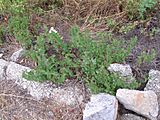Vitis rupestris facts for kids
Quick facts for kids Vitis rupestris |
|
|---|---|
 |
|
| Conservation status | |
| Scientific classification | |
| Genus: |
Vitis
|
| Species: |
rupestris
|
Vitis rupestris is a type of grape plant that grows naturally in the United States. It has many common names, like July grape, Coon grape, sand grape, and rock grape. This plant is very important for making new kinds of hybrid grapes and for creating strong root systems for other grapevines. One well-known type, called Rupestris St. George, is often used for breeding and as a rootstock.
Contents
Where This Grape Grows
Native Home of Vitis rupestris
Most Vitis rupestris plants grow in the Ozark Hills of Missouri and Arkansas. You can also find smaller groups of these plants further east, in places like Pennsylvania, and southwest, in Oklahoma and Texas. Some reports say it grows near San Francisco Bay in California, but these are probably plants that escaped from gardens.
How It Lives in Nature
Vitis rupestris is a bushy plant that stands up on its own. It needs a lot of sunlight and only grows on rocky riverbanks and streambanks. Sadly, many of the places where it naturally grows have been destroyed. This happens when rivers are dammed or when islands are removed to make way for boats. Because of this, Vitis rupestris is now listed as threatened or endangered in states like Indiana, Kentucky, Pennsylvania, and Tennessee. The wild places where this grape lives are quickly disappearing.
Blending with Other Grapes
In some areas, Vitis rupestris naturally mixes with other grape types. It can hybridize with the Riverbank grape and other Vitis species. This means they can create new grape plants that are a mix of both types.
What Vitis rupestris Looks Like
Plant Growth and Roots
This grape plant usually grows straight up and has many branches. It rarely climbs higher than 4 to 8 feet (about 1.2 to 2.4 meters). Its roots are thin, strong, and grow very deep. These deep roots help the plant find water far underground, which means it can survive well during dry times.
Stems and Buds
When the wood is young, it is smooth and red. As it gets older, it becomes round and has fine lines, with dark bark that gets even darker over time. The wood is quite strong and dense. The buds on the plant are small and round or slightly cone-shaped.
Leaves and Tendrils
The leaves are long and narrow, with large leaf-like parts called stipules. The veins on the leaves are often crimson red. The leaf stems have deep grooves. The leaves themselves usually have clear lines and feel smooth. They are typically 3 to 4 inches (about 7.5 to 10 cm) wide, sometimes up to 5 inches (12.5 cm). The plant also has small, crimson-colored tendrils, which are like tiny arms that help it grip things.
Flowers and Fruit
The grape clusters are very small. The main stem of the cluster is smooth and light green. The flowers are fertile, meaning they can produce fruit. They have stamens (the parts that make pollen) that curve back. These flowers make a lot of pollen.
The fruits are small, about 1/4 to 1/2 inch (0.6 to 1.2 cm) wide. They are round or slightly flat around the stem. Sometimes, two berries might grow together. The berries are black with very little waxy coating. Their skin is thin and soft, and the inside pulp is tender and melts in your mouth. The pulp is a deep crimson or violet color and sticks closely to the skin. Each berry usually has 3 to 4 small seeds. The clusters of berries are about 8 inches (20 cm) long.
Quick Growth and Reproduction
The seeds of Vitis rupestris grow quickly, and the fruit ripens early in the season. If the plant's wood from the previous year gets damaged by winter, it can still grow new shoots from 2 to 4-year-old wood and produce fruit. This plant also grows easily from cuttings. Its pollen is very strong and good at fertilizing and mixing with other Vitis species to create new hybrids.
How It Fights Pests and Diseases
Strong Against Dry Weather
Vitis rupestris is very good at resisting dry weather. This is thanks to its deep roots that can reach water far underground. However, if it can't reach deep water, it can still get hurt by drought.
Protecting Leaves from Pests
The leaves of this plant are very good at fighting off fungus and insect attacks. Even though many grazing animals like to eat it, it usually doesn't get much damage from them. It is sometimes attacked by a disease called anthracnose, but it usually doesn't get badly hurt. It is also resistant to black rot, downy mildew, and powdery mildew, which are common grape diseases.
Why This Grape Is Important
Creating New Grape Varieties
Vitis rupestris is widely used to create new hybrid grape varieties. It is often crossed with other species, especially Vitis vinifera (the common wine grape) and Vitis lincecumii. The goal is to make new grapes that can resist diseases. This species was very important for developing grapes that could grow on their own roots and fight off attacks from tiny insects called Phylloxera and a disease called Downy mildew.
Famous Grape Breeders
Many famous grape breeders used Vitis rupestris in their work. These include T.V. Munson, Albert Seibel (who created Seibel grapes), Joannes Seyve, and Elmer Swenson. Even though it was very useful, Vitis rupestris was often overlooked in its home country in favor of the Fox grape (Vitis labrusca).
Modern Grape Types
Today, many European "PIWI" grape varieties (which stands for "fungus-resistant") that are classified as Vitis vinifera actually have Vitis rupestris in their family tree. Examples include grapes like Solaris and Regent.
Gallery
- Vitis rupestris
See also
 In Spanish: Vitis rupestris para niños
In Spanish: Vitis rupestris para niños





